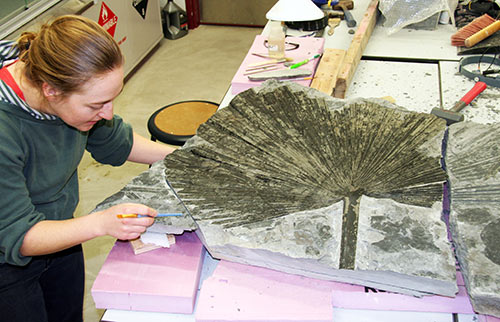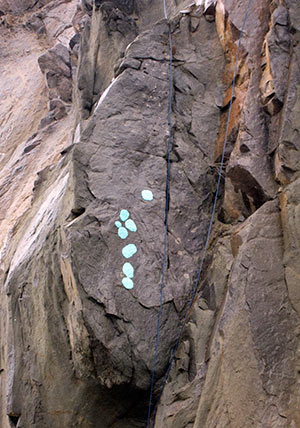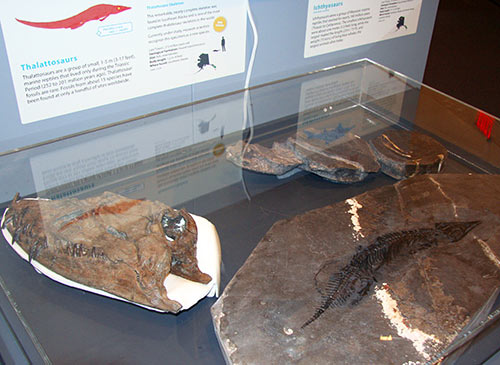
Finding fossils in AlaskaBy THERESA BAKKER
June 08, 2015
How do we know? It’s all in the fossil record. Animal fossils can tell you who used to live here and what they were eating. Plant fossils can tell you about the vegetation that grew here and whether the climate was warmer or cooler than today.
Julie Rousseau, earth sciences collection manager, prepares a palm frond fossil discovered in Southeast Alaska.
In a new exhibit at the University of Alaska Museum of the North called “Expedition Alaska: Dinosaurs,” visitors can see a variety of Alaska fossils, including a six-foot wide palm leaf discovered last year in Southeast during the filming of a documentary about the geologic history of North America. The very presence of palm trees in this region indicates a much warmer period in Earth’s history. There are different types of fossils. Body fossils are the bones, shells and teeth that have survived a long burial in the earth. Trace fossils are the marks the animals left behind, like dinosaur tracks or even their dung, called “coprolites” in paleontology terms. The clues offered by these different types of fossils are similar to what we use for modern animals today. Sometimes we see the whole animal, a moose or bear in the woods, or a dead shrew on the forest floor. More often we find signs of the animal, things like tracks, gnawed trees or bits of fur on branches. This kind of knowledge and the ability to use it to reconstruct what happened is similar to the way paleontologists learn the story of the ancient past from fossils. When Druckenmiller arrived at the museum, he found a photograph on his desk that featured an interesting set of dinosaur footprints running up the side of a rock face in Southwest Alaska. He also found a note saying they might be rocks from the Jurassic Period. “That made me excited because these would be the only Jurassic dinosaurs found in the state.” n the summer of 2010, Druckenmiller and other scientists set up camp in a remote mountain range on the Alaska Peninsula where they found the dinosaur tracks from the photo. The researchers learned that they were made by meat-eating dinosaurs, a rare find in Alaska. They also confirmed that the rocks were Jurassic in age, which pushed the fossil record of dinosaurs in Alaska back about 50 million years. Instead of slicing off the side of the cliff and bringing the footprints home with them, the crew spent the next several days making peels. The original footprints are impressions in the sandstone, so they used a silicone molding compound, pressing the material into the track and letting it set into a flexible peel they could easily carry to the museum.
One of the most complete thalattosaur fossils in the world, show at lower right, was found in Alaska.
Many of Alaska’s dinosaurs lived above the Arctic Circle, the northernmost dinosaurs that may have ever existed on the planet. The Mesozoic was a critical era in the state’s geological history. As Alaska was taking shape, powerful tectonic forces slammed new pieces of land against others, creating mountains. Then erosion carried sediment into rivers and shallow seas, entombing the remains of some of the dinosaurs and marine reptiles of ancient Alaska.
On the Web:
Theresa Bakker [tabakker@alaska.edu] is a communication manager: feature writing and editing, with the Alaska Museum of the North.
|
|||


